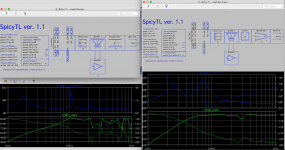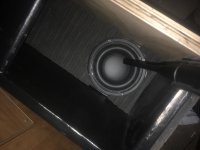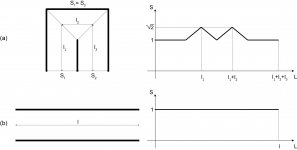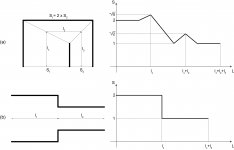Hi everyone,
SpicyTL is online and available for download.
SpicyTL is a simulation model, based on the electrical circuit theory, which predicts the electro-acoustic behavior of transmission line loudspeaker systems. It is the evolution of the AIRDAMP model, whose development (and the principles that allow its operation) is illustrated in the article Progettare una linea di trasmissione utilizzando SPICE (Designing a Transmission Line with SPICE), published in issues 408, 409 and 410 (April, May and June 2019) of AUDIOreview. Compared to the latter, SpicyTL has a modular structure composed of several acoustic blocks and can also simulate tapered and expanding TL's.
The model, particularly suitable to design a TL damped with polyurethane foam, allows to simulate frequency response, phase response, group delay, electrical impedance, speaker cone excursion and air velocity at the TL output.
Operating instruction and download at the following address:
SpicyTL-english – Transmission Line Speakers
An in-depth look at the software, and its use for designing the Ikigai monitors, can be found in the article Progettiamo una linea di trasmissione con SpicyTL (Designing a Transmission Line with SpicyTL) on the 427th issue (January 2021) of AUDIOreview.
Kind regards,
Andrea
SpicyTL is online and available for download.
SpicyTL is a simulation model, based on the electrical circuit theory, which predicts the electro-acoustic behavior of transmission line loudspeaker systems. It is the evolution of the AIRDAMP model, whose development (and the principles that allow its operation) is illustrated in the article Progettare una linea di trasmissione utilizzando SPICE (Designing a Transmission Line with SPICE), published in issues 408, 409 and 410 (April, May and June 2019) of AUDIOreview. Compared to the latter, SpicyTL has a modular structure composed of several acoustic blocks and can also simulate tapered and expanding TL's.
The model, particularly suitable to design a TL damped with polyurethane foam, allows to simulate frequency response, phase response, group delay, electrical impedance, speaker cone excursion and air velocity at the TL output.
Operating instruction and download at the following address:
SpicyTL-english – Transmission Line Speakers
An in-depth look at the software, and its use for designing the Ikigai monitors, can be found in the article Progettiamo una linea di trasmissione con SpicyTL (Designing a Transmission Line with SpicyTL) on the 427th issue (January 2021) of AUDIOreview.
Kind regards,
Andrea
Last edited:
Andrea,
Interesting to see a speaker simulation program that will run on the Mac OS!
Have been in “simulation withdrawal” since my PC died almost a year ago.
Will take a lot of learning to figure out how to change parameters in SpicyTL, but it looks promising.
Have you compared SpicyTL simulations to Hornresp, and if so, what areas of agreement or disagreement do you find?
I did not see a radiation angle (free space, half space, 1/4, 1/8 space) parameter, which is assumed in the SpicyTL simulation?
Thanks,
Art
Interesting to see a speaker simulation program that will run on the Mac OS!
Have been in “simulation withdrawal” since my PC died almost a year ago.
Will take a lot of learning to figure out how to change parameters in SpicyTL, but it looks promising.
Have you compared SpicyTL simulations to Hornresp, and if so, what areas of agreement or disagreement do you find?
I did not see a radiation angle (free space, half space, 1/4, 1/8 space) parameter, which is assumed in the SpicyTL simulation?
Thanks,
Art
Attachments
On a Mac great. I have LT-spice downloades but get nowhere downloading the spicyTL file (i get something called “SpicyTL.zip.html” which is not a vaild html or zip file [21k]).
What is the likelihood that models for better damping than foam (who's only asset is consistency?
dave
What is the likelihood that models for better damping than foam (who's only asset is consistency?
dave
I've been eagerly awaiting the publication of SpicyTL and looking forward to giving it a try.
Thank you, Andrea!
Thank you, I await your impressions
Andrea
I'm not sure I understand your question.
Thanx Andrea,
Do you plan on adding materials other than foam since it is not great at damping) with better damping materials?
dave
Hi Dave,
thanks, it's clearer now.
I have developed some models that predict very well the behavior of fibrous materials, especially Dacron, but I have not yet included them in SpicyTL. Actually also in SpicyTL there is a block (straight_fiber) that can simulate a straight line filled with fiber by defining the percentage of filling, but it is a somewhat limited tool within an elaborate design.
The main reason I focused on foam is that I firmly believe it is the best material to use for TL dampening.
thanks, it's clearer now.
I have developed some models that predict very well the behavior of fibrous materials, especially Dacron, but I have not yet included them in SpicyTL. Actually also in SpicyTL there is a block (straight_fiber) that can simulate a straight line filled with fiber by defining the percentage of filling, but it is a somewhat limited tool within an elaborate design.
The main reason I focused on foam is that I firmly believe it is the best material to use for TL dampening.
Very, very cool!
Thanks for your hard work on this. It makes TL simulation accessible to more people.
One question; would it be difficult to modify the modelling to include the option of a mass loaded TL? In other words, to add the option of terminating the line with a vent, rather than a simple open end.
Thanks for your hard work on this. It makes TL simulation accessible to more people.
One question; would it be difficult to modify the modelling to include the option of a mass loaded TL? In other words, to add the option of terminating the line with a vent, rather than a simple open end.
...the option of terminating the line with a vent...
Officially called a restricted terminus.
dave
Very, very cool!
Thanks for your hard work on this. It makes TL simulation accessible to more people.
One question; would it be difficult to modify the modelling to include the option of a mass loaded TL? In other words, to add the option of terminating the line with a vent, rather than a simple open end.
Thanks cogitech,
I have already developed a "port" block that can be positioned at will along the TL, but I have not yet tested it sufficiently.
I hope to complete and integrate it into SpicyTL as soon as possible.
Acoustic ‘foam’ (pic) ? Or the bulkier mattress pad eggshell stuff? it would be cool to see what i could get from various amounts of either
I'm talking about polyurethane foam with typical density of 30 kg/m3
Andrea
Andrea, I finally found a little time to play with SpicyTL. You were very clever to create a library of components in LTspice that can be put together like Lego blocks to model any Transmission Line structure. It is reassuring to see that SpicyTL and Hornresp agree so closely.Thank you, I await your impressions
Andrea
Would you kindly answer a few questions that came up as I experimented?
1. The 90- and 180-degree Bend elements are interesting. Do they model the increase and then decrease in area as the line turns the corner? How is line length around the bend computed?
2. Changing the "Line_width" parameter didn't seem to have an effect. What should have been expected?
3. What is the assumed distance from the driver to the open end? Is there a way to change it?
4. The effect of changing "S-foam" is very apparent, but I'm not quite sure how to relate the number to actual stuffing density. Can you explain that relationship? Will you also say why you believe foam is the best material to use for TL dampening?
5. Finally, can LTspice's more advanced capabilities, such as parameter sweeping and Monte Carlo analysis, be used with SpicyTL?
[For those unfamiliar with the term, parameter sweeping involves automatically running several simulations while changing a parameter (like stuffing density or driver position) in steps over some range. The results of the simulations are plotted on the same graph to show how the response changes as the parameter varies. Monte Carlo analysis is similar except that many simulations are usually run, with the values of several parameters chosen randomly for each run (like drawing a poker hand from a deck of cards). It would be a way to make sure a design works well even if the actual driver doesn't exactly match its published TS parameters.]
Thank you, Andrea, for all your effort in making SpicyTL. IMHO, it shows great promise.
1. Yes they model the change in area as a function of TL length.1. The 90- and 180-degree Bend elements are interesting. Do they model the increase and then decrease in area as the line turns the corner? How is line length around the bend computed?
2. Changing the "Line_width" parameter didn't seem to have an effect. What should have been expected?
In Figure 1a you can see how the unit area of a square section TL varies as the length varies, measured at the center of it, in the case of a 180° bend angle; in Figure 1b you can see the same line length, but without the bend. A simulation that does not take the fold into account refers to this second model.
If in correspondence of the fold a section change occurs, then also the real length of the transmission line will be different from the simulated one because l1+l2+l3 is always greater than l. In Figure 2a you can see an example of TL of unit width and section that halves in correspondence of the fold; in Figure 2b the section variation interpreted by a simulation that does not take into account the fold.
The section variation in the bend is calculated from the area of the inlet section "S_in", the area of the middle section "SL", the area of the outlet section "S_out" and the global parameter "line_width".
2. The "Line_width" parameter has an effect only if there are folds in the model.
Tests made with measurements have shown that the effect is more pronounced in the final sections of the TL and increases as the size of the TL increases.
Attachments
3. What is the assumed distance from the driver to the open end? Is there a way to change it?
I've developed a model that takes into account the distance between the speaker and the port and the mutual coupling between them but I haven't included it in SpicyTL yet. I think it can be integrated into a block to make it affordable to use.
4. The effect of changing "S-foam" is very apparent, but I'm not quite sure how to relate the number to actual stuffing density. Can you explain that relationship?
"S_foam" does not represent a stuffing density, it represent the area of the TL section occupied by the foam in cm²
Modeling the effect of a TL partially filled with absorbent material is the main feature of SpicyTL. I refer you to reading this article:
The Simulation with Foam – Transmission Line Speakers
Will you also say why you believe foam is the best material to use for TL dampening?
I explain it here:
The Speed of Sound in the Transmission Line Pt.2 – Transmission Line Speakers
- Home
- Loudspeakers
- Subwoofers
- SpicyTL - Transmission Line Simulation Model




